
Chapter 6: Energy for Life
6.1 Overview of Photosynthesis
Photosynthesis is the process by which plants, Algae, and cyanobacteria use sunlight to convert carbon dioxide and water into oxygen and carbohydrates.
Photosynthetic organisms produce an enormous amount of carbohydrates, which are essential for life on Earth.
The energy stored in the carbohydrates produced by photosynthetic organisms is used to sustain life on Earth, including the plants themselves, animals, and humans.
Fossil fuels, such as coal and oil, are formed from the remains of ancient photosynthetic organisms.
The fermentation of plant materials produces alcohol, which can be used as a fuel.
Plants, such as flowers and mosses, typically live on land.
Photosynthetic protists, such as Euglena, diatoms, and kelp, typically live in water.
Cyanobacteria is a type of bacterium that lives everywhere.
Plants as Photosynthesizers
The steps to photosynthesis are as follows:
Step 1: Carbon dioxide enters the leaf through small openings called stomata.
Step 2: Water is absorbed by the roots and moves up the stem to the leaves.
Step 3: CO2 and water diffuse into mesophyll cells, where they enter chloroplasts.
Step 4: Chlorophyll in the chloroplasts absorbs sunlight and uses the energy to convert CO2 and water into oxygen and glucose.
Step 5: Oxygen is released into the air.
Step 6: Glucose is used by the plant for energy or stored for later use.
Raw materials for photosynthesis
Carbon dioxide
Water
Parts of a chloroplast
Grana
Stroma
Grana
Made up of thylakoids
Contain photosynthetic pigments, such as chlorophyll
Absorb solar energy
Stroma
Fluid-filled space
Where carbon dioxide is enzymatically processed to form carbohydrates, such as glucose.
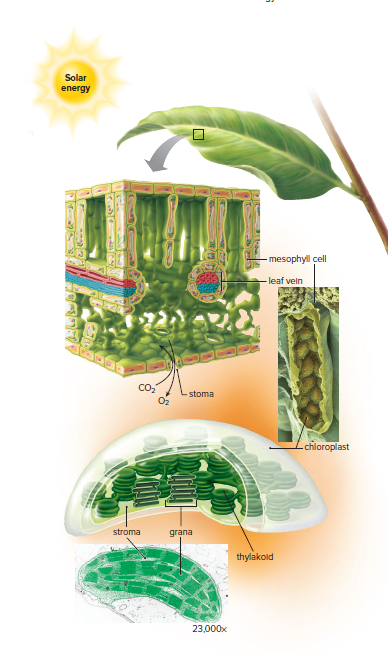
The photosynthetic Process
Carbon dioxide (CO2) and water (H 2O), the reactants for photosynthesis, contain much less energy than the end product, carbohydrate (CH 2O).
Sunlight provides the needed energy to allow for photosynthesis to occur.
During photosynthesis, electrons are removed from water molecules and energized by solar energy.
An enzyme called NADP+ then transfers these high-energy electrons to carbon dioxide, forming carbohydrates.
The electrons are accompanied by Hydrogen Ions (H+), which is why it is possible to track the movement of electrons during photosynthesis.

The process of photosynthesis consists of light reactions and the Calvin cycle reactions.
Light reactions
Occur in the thylakoid membrane of chloroplasts
Use light energy to split water molecules into hydrogen and oxygen
Use the hydrogen to produce ATP and NADPH
Calvin cycle
Occurs in the stroma of chloroplasts
Uses ATP and NADPH to reduce carbon dioxide into glucose
Releases oxygen as a byproduct
Reduction is the gain of electrons and hydrogen ions by a molecule.
Oxidation is the loss of electrons and hydrogen ions by a molecule.
Redox reactions are coupled reactions that involve oxidation and reduction.
In a cell, reduction reactions are often coupled with oxidation reactions to produce energy.
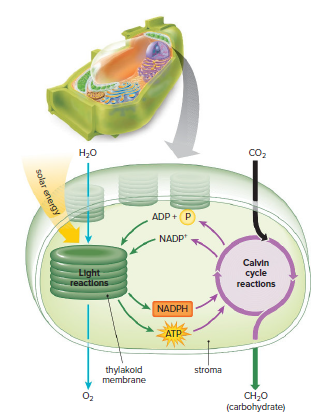
6.2 The Light Reactions--Harvesting Energy
During the light reactions of photosynthesis, the pigments within the thylakoid membranes absorb solar energy.
Solar energy (also called radiant energy) can be described in terms of its wavelength and its energy content.
The electromagnetic spectrum is a continuous range of radiant energy, with different wavelengths corresponding to different amounts of energy.
Visible light is a form of electromagnetic radiation that can be seen by the human eye.
Visible light is made up of different wavelengths, each of which corresponds to a different color.
The wavelengths of visible light range from about 380 nanometers (violet) to about 700 nanometers (red).
Less than 50% of solar radiation that hits the Earth's atmosphere reaches its surface.
Most of the radiation that reaches the Earth's surface is within the visible light range.
Higher-energy wavelengths are screened out by the ozone layer in the atmosphere.
Lower-energy wavelengths are screened out by water vapor and CO2.
Both the organic molecules within organisms and certain life processes, such as vision and photosynthesis, are adapted to utilize the radiation that is most prevalent in the environment.
Photosynthetic Pigments
Chlorophylls and carotenoids are the main pigments found in photosynthetic cells.
Chlorophylls absorb violet, blue, and red wavelengths of light.
Green light is reflected by chlorophylls, which is why leaves appear green.
Carotenoids absorb violet-blue-green wavelengths of light but not yellow-orange wavelengths.
In the fall, when chlorophyll breaks down, carotenoids become more noticeable, giving leaves their yellow, orange, and red colors.
The Light Reactions: Capturing Solar Energy
Light reactions capture the sun’s energy and store it in the form of a hydrogen ion (H+) gradient.
This hydrogen ion gradient is used to produce ATP molecules.
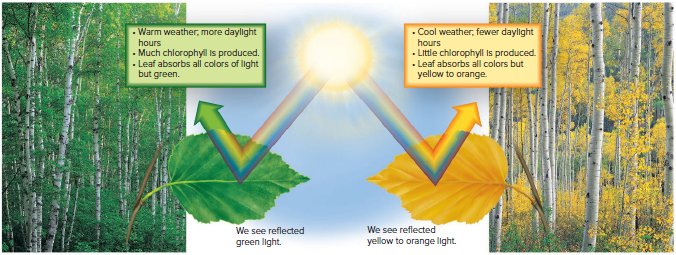

The light reactions produce an important molecule called NADPH.
The light reactions use two photosystems:
Photosystem I (PS I).
photosystem II (PS II).
The photosystems are named for the order in which they were discovered.
Photosystem I (PS I) and photosystem II (PS II) are two protein complexes that use light energy to split water and generate ATP and NADPH.
PS I and PS II each consist of a pigment complex and an electron acceptor. The pigment complex absorbs light energy and passes it to the reaction center, where it is used to excite electrons.
PS II splits water, releasing oxygen and hydrogen ions. The hydrogen ions are used to generate ATP in the electron transport chain.
PS I produces NADPH by passing electrons from the electron transport chain to NADP+.
The Electron Transport Chain
PS I, PS II, and the electron transport chain are molecular complexes located within the thylakoid membrane.
The molecular complexes are densely clustered to promote efficient electron transfer between carriers.
The ATP synthase complex is also present.
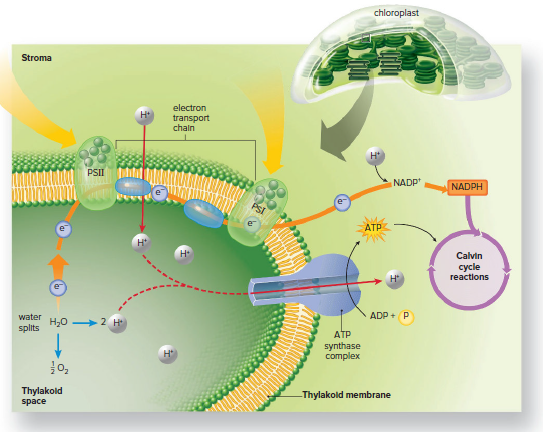
ATP Production
During photosynthesis, the thylakoid space acts as a reservoir for hydrogen ions (H+).
Water is split, releasing two H+ ions into the thylakoid space.
Electrons move from carrier to carrier down the electron transport chain, releasing energy.
This energy is used to pump H+ ions from the stroma into the thylakoid space.
This creates a H+ gradient, with more H+ ions in the thylakoid space than in the stroma.
The H+ ions then flow down their concentration gradient across the thylakoid membrane at the ATP synthase complex.
This releases energy, which causes the ATP synthase complex to change shape and produce ATP from ADP + P.
The production of ATP captures the released energy.
NADPH Production
NADP+ is a coenzyme that accepts electrons and a hydrogen ion to become NADPH.
NADPH is produced in the light reactions of photosynthesis when NADP+ receives electrons and a hydrogen ion from the electron transport chain.
6.3 The Calvin Cycle Reactions--Making Sugars
The light reactions of photosynthesis generate ATP and NADPH.
The Calvin cycle is the second stage of photosynthesis and is powered by the previously generated ATP and NADPH.
The Calvin cycle is also known as the light-independent reaction because it does not require an input of solar energy.
The Calvin cycle was named after Melvin Calvin, who used the radioactive isotope 14C to discover the reactions that make up the cycle.
Overview of the Calvin Cycle
The Calvin cycle is a series of chemical reactions that use carbon dioxide (CO2) from the atmosphere to produce glucose and other organic molecules.
The Calvin cycle has three steps:
CO2 fixation: CO2 is combined with RuBP (ribulose-1,5-bisphosphate) to form two molecules of 3-phosphoglycerate (3-PGA).
CO2 reduction: 3-PGA is reduced using ATP and NADPH from the light reactions to form G3P (glyceraldehyde 3-phosphate).
Regeneration of the first substrate: G3P is used to regenerate RuBP, which can then be used to fix more CO2.
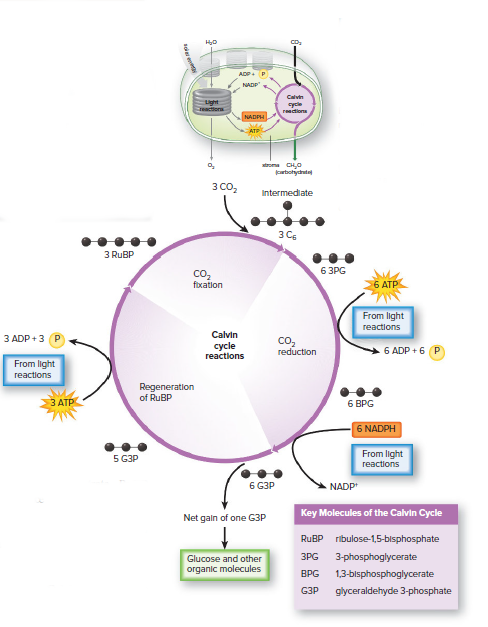
Fixation of Carbon Dioxide
Carbon dioxide (CO2) fixation is the first step of the Calvin cycle.
In this reaction, CO2 from the atmosphere is attached to RuBP, a 5-carbon molecule.
The enzyme for this reaction is called RuBP carboxylase (rubisco), and the result is a 6-carbon molecule that soon thereafter splits into two 3-carbon molecules.
Reduction of Carbon Dioxide
Reduction of CO2 is the process of using NADPH and ATP to convert carbon dioxide into carbohydrates.
NADPH provides the electrons needed for the reduction reaction, while ATP provides the energy.
Electrons are added to carbon dioxide one at a time, and through a series of reactions, G3P is formed.
G3P is a carbohydrate that can be used by the plant for energy or stored for later use.
Regeneration of RuBP
The Calvin cycle is a cyclic process, which means that some of the products of the reactions are used to regenerate the starting materials.
The final stage of the Calvin cycle uses ATP from the light reactions to regenerate RuBP, which is the molecule that starts the cycle.
This regeneration of RuBP allows the Calvin cycle to continue and ultimately to produce glucose from carbon dioxide and water.
The Fate of G3P
Algae and plants have enormous biochemical capabilities compared to animal cells.
From a G3P molecule, they can make all the molecules they need.
A plant can utilize the hydrocarbon skeleton of G3P to form fatty acids and glycerol.
When nitrogen is added to the hydrocarbon skeleton derived from G3P, amino acids are formed.
6.4 Variations in Photosynthesis
Evergreen trees in cold, windy climates have small, narrow leaves that look like needles. These leaves help the trees to conserve water and energy.
Evergreen trees in warm, wet climates have large, flat leaves to catch the rays of the sun. These leaves help the trees to photosynthesize and produce food.
C3 Photosynthesis
C3 plants are the most common type of plant.
They are found in moderate climates with average temperatures and rainfall.
C3 photosynthesis is the process by which C3 plants fix carbon dioxide.
The first detectable molecule after CO2 fixation in C3 plants is a molecule with three carbon atoms.
C3 photosynthesis occurs in the chloroplasts of mesophyll cells.
If the weather is hot and dry, stomata close to prevent the loss of water.
This also prevents CO2 from entering the leaf, which reduces the efficiency of photosynthesis.
The competition between CO2 and O2 for the active site of rubisco is called photorespiration.
Photorespiration reduces the efficiency of photosynthesis in C3 plants in hot, dry conditions.
C4 Photosynthesis
C4 photosynthesis is a type of photosynthesis that is used by some plants in hot, dry conditions.
C4 photosynthesis differs from C3 photosynthesis in that it has two stages:
In the first stage, CO2 is fixed in the mesophyll cells by a C3 molecule and a C4 molecule forms.
In the second stage, the C4 molecule is modified and then pumped into bundle sheath cells. Then CO2 enters the Calvin cycle.
C4 photosynthesis is more efficient than C3 photosynthesis in hot, dry conditions because it helps to prevent photorespiration.
Photorespiration is a wasteful process that occurs when rubisco, the enzyme that fixes CO2, accidentally binds to O2 instead.

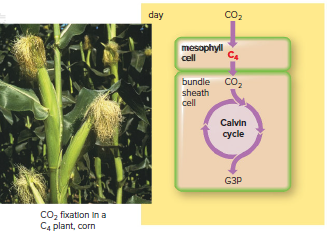
CAM Photosynthesis
CAM photosynthesis is a type of photosynthesis that uses partitioning in time to conserve water.
CAM plants open their stomata at night to take in CO2, which is then stored in vacuoles in mesophyll cells.
During the day, the stomata close to conserve water, and the CO2 is released from the vacuoles to the Calvin cycle.
CAM photosynthesis is less efficient than other types of photosynthesis, but it allows CAM plants to live in dry environments.
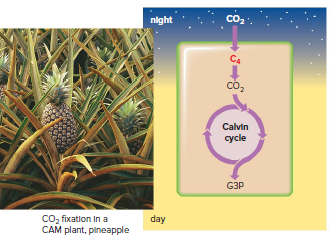
Evolutionary Trends
C4 plants are adapted to areas of high light intensities, high temperatures, and limited rainfall.
C4 plants are more sensitive to cold than C3 plants.
C3 plants probably do better than C4 plants below 25°C (77°F).
CAM plants compete well with either C3 or C4 plants in extremely arid environments.
CAM photosynthesis is widespread and has evolved in 30 families of flowering plants, including cacti, stonecrops, orchids, and bromeliads.
CAM photosynthesis is also found among nonflowering plants, such as some ferns and cone-bearing trees.
Chapter 6: Energy for Life
6.1 Overview of Photosynthesis
Photosynthesis is the process by which plants, Algae, and cyanobacteria use sunlight to convert carbon dioxide and water into oxygen and carbohydrates.
Photosynthetic organisms produce an enormous amount of carbohydrates, which are essential for life on Earth.
The energy stored in the carbohydrates produced by photosynthetic organisms is used to sustain life on Earth, including the plants themselves, animals, and humans.
Fossil fuels, such as coal and oil, are formed from the remains of ancient photosynthetic organisms.
The fermentation of plant materials produces alcohol, which can be used as a fuel.
Plants, such as flowers and mosses, typically live on land.
Photosynthetic protists, such as Euglena, diatoms, and kelp, typically live in water.
Cyanobacteria is a type of bacterium that lives everywhere.
Plants as Photosynthesizers
The steps to photosynthesis are as follows:
Step 1: Carbon dioxide enters the leaf through small openings called stomata.
Step 2: Water is absorbed by the roots and moves up the stem to the leaves.
Step 3: CO2 and water diffuse into mesophyll cells, where they enter chloroplasts.
Step 4: Chlorophyll in the chloroplasts absorbs sunlight and uses the energy to convert CO2 and water into oxygen and glucose.
Step 5: Oxygen is released into the air.
Step 6: Glucose is used by the plant for energy or stored for later use.
Raw materials for photosynthesis
Carbon dioxide
Water
Parts of a chloroplast
Grana
Stroma
Grana
Made up of thylakoids
Contain photosynthetic pigments, such as chlorophyll
Absorb solar energy
Stroma
Fluid-filled space
Where carbon dioxide is enzymatically processed to form carbohydrates, such as glucose.

The photosynthetic Process
Carbon dioxide (CO2) and water (H 2O), the reactants for photosynthesis, contain much less energy than the end product, carbohydrate (CH 2O).
Sunlight provides the needed energy to allow for photosynthesis to occur.
During photosynthesis, electrons are removed from water molecules and energized by solar energy.
An enzyme called NADP+ then transfers these high-energy electrons to carbon dioxide, forming carbohydrates.
The electrons are accompanied by Hydrogen Ions (H+), which is why it is possible to track the movement of electrons during photosynthesis.

The process of photosynthesis consists of light reactions and the Calvin cycle reactions.
Light reactions
Occur in the thylakoid membrane of chloroplasts
Use light energy to split water molecules into hydrogen and oxygen
Use the hydrogen to produce ATP and NADPH
Calvin cycle
Occurs in the stroma of chloroplasts
Uses ATP and NADPH to reduce carbon dioxide into glucose
Releases oxygen as a byproduct
Reduction is the gain of electrons and hydrogen ions by a molecule.
Oxidation is the loss of electrons and hydrogen ions by a molecule.
Redox reactions are coupled reactions that involve oxidation and reduction.
In a cell, reduction reactions are often coupled with oxidation reactions to produce energy.

6.2 The Light Reactions--Harvesting Energy
During the light reactions of photosynthesis, the pigments within the thylakoid membranes absorb solar energy.
Solar energy (also called radiant energy) can be described in terms of its wavelength and its energy content.
The electromagnetic spectrum is a continuous range of radiant energy, with different wavelengths corresponding to different amounts of energy.
Visible light is a form of electromagnetic radiation that can be seen by the human eye.
Visible light is made up of different wavelengths, each of which corresponds to a different color.
The wavelengths of visible light range from about 380 nanometers (violet) to about 700 nanometers (red).
Less than 50% of solar radiation that hits the Earth's atmosphere reaches its surface.
Most of the radiation that reaches the Earth's surface is within the visible light range.
Higher-energy wavelengths are screened out by the ozone layer in the atmosphere.
Lower-energy wavelengths are screened out by water vapor and CO2.
Both the organic molecules within organisms and certain life processes, such as vision and photosynthesis, are adapted to utilize the radiation that is most prevalent in the environment.
Photosynthetic Pigments
Chlorophylls and carotenoids are the main pigments found in photosynthetic cells.
Chlorophylls absorb violet, blue, and red wavelengths of light.
Green light is reflected by chlorophylls, which is why leaves appear green.
Carotenoids absorb violet-blue-green wavelengths of light but not yellow-orange wavelengths.
In the fall, when chlorophyll breaks down, carotenoids become more noticeable, giving leaves their yellow, orange, and red colors.
The Light Reactions: Capturing Solar Energy
Light reactions capture the sun’s energy and store it in the form of a hydrogen ion (H+) gradient.
This hydrogen ion gradient is used to produce ATP molecules.


The light reactions produce an important molecule called NADPH.
The light reactions use two photosystems:
Photosystem I (PS I).
photosystem II (PS II).
The photosystems are named for the order in which they were discovered.
Photosystem I (PS I) and photosystem II (PS II) are two protein complexes that use light energy to split water and generate ATP and NADPH.
PS I and PS II each consist of a pigment complex and an electron acceptor. The pigment complex absorbs light energy and passes it to the reaction center, where it is used to excite electrons.
PS II splits water, releasing oxygen and hydrogen ions. The hydrogen ions are used to generate ATP in the electron transport chain.
PS I produces NADPH by passing electrons from the electron transport chain to NADP+.
The Electron Transport Chain
PS I, PS II, and the electron transport chain are molecular complexes located within the thylakoid membrane.
The molecular complexes are densely clustered to promote efficient electron transfer between carriers.
The ATP synthase complex is also present.

ATP Production
During photosynthesis, the thylakoid space acts as a reservoir for hydrogen ions (H+).
Water is split, releasing two H+ ions into the thylakoid space.
Electrons move from carrier to carrier down the electron transport chain, releasing energy.
This energy is used to pump H+ ions from the stroma into the thylakoid space.
This creates a H+ gradient, with more H+ ions in the thylakoid space than in the stroma.
The H+ ions then flow down their concentration gradient across the thylakoid membrane at the ATP synthase complex.
This releases energy, which causes the ATP synthase complex to change shape and produce ATP from ADP + P.
The production of ATP captures the released energy.
NADPH Production
NADP+ is a coenzyme that accepts electrons and a hydrogen ion to become NADPH.
NADPH is produced in the light reactions of photosynthesis when NADP+ receives electrons and a hydrogen ion from the electron transport chain.
6.3 The Calvin Cycle Reactions--Making Sugars
The light reactions of photosynthesis generate ATP and NADPH.
The Calvin cycle is the second stage of photosynthesis and is powered by the previously generated ATP and NADPH.
The Calvin cycle is also known as the light-independent reaction because it does not require an input of solar energy.
The Calvin cycle was named after Melvin Calvin, who used the radioactive isotope 14C to discover the reactions that make up the cycle.
Overview of the Calvin Cycle
The Calvin cycle is a series of chemical reactions that use carbon dioxide (CO2) from the atmosphere to produce glucose and other organic molecules.
The Calvin cycle has three steps:
CO2 fixation: CO2 is combined with RuBP (ribulose-1,5-bisphosphate) to form two molecules of 3-phosphoglycerate (3-PGA).
CO2 reduction: 3-PGA is reduced using ATP and NADPH from the light reactions to form G3P (glyceraldehyde 3-phosphate).
Regeneration of the first substrate: G3P is used to regenerate RuBP, which can then be used to fix more CO2.

Fixation of Carbon Dioxide
Carbon dioxide (CO2) fixation is the first step of the Calvin cycle.
In this reaction, CO2 from the atmosphere is attached to RuBP, a 5-carbon molecule.
The enzyme for this reaction is called RuBP carboxylase (rubisco), and the result is a 6-carbon molecule that soon thereafter splits into two 3-carbon molecules.
Reduction of Carbon Dioxide
Reduction of CO2 is the process of using NADPH and ATP to convert carbon dioxide into carbohydrates.
NADPH provides the electrons needed for the reduction reaction, while ATP provides the energy.
Electrons are added to carbon dioxide one at a time, and through a series of reactions, G3P is formed.
G3P is a carbohydrate that can be used by the plant for energy or stored for later use.
Regeneration of RuBP
The Calvin cycle is a cyclic process, which means that some of the products of the reactions are used to regenerate the starting materials.
The final stage of the Calvin cycle uses ATP from the light reactions to regenerate RuBP, which is the molecule that starts the cycle.
This regeneration of RuBP allows the Calvin cycle to continue and ultimately to produce glucose from carbon dioxide and water.
The Fate of G3P
Algae and plants have enormous biochemical capabilities compared to animal cells.
From a G3P molecule, they can make all the molecules they need.
A plant can utilize the hydrocarbon skeleton of G3P to form fatty acids and glycerol.
When nitrogen is added to the hydrocarbon skeleton derived from G3P, amino acids are formed.
6.4 Variations in Photosynthesis
Evergreen trees in cold, windy climates have small, narrow leaves that look like needles. These leaves help the trees to conserve water and energy.
Evergreen trees in warm, wet climates have large, flat leaves to catch the rays of the sun. These leaves help the trees to photosynthesize and produce food.
C3 Photosynthesis
C3 plants are the most common type of plant.
They are found in moderate climates with average temperatures and rainfall.
C3 photosynthesis is the process by which C3 plants fix carbon dioxide.
The first detectable molecule after CO2 fixation in C3 plants is a molecule with three carbon atoms.
C3 photosynthesis occurs in the chloroplasts of mesophyll cells.
If the weather is hot and dry, stomata close to prevent the loss of water.
This also prevents CO2 from entering the leaf, which reduces the efficiency of photosynthesis.
The competition between CO2 and O2 for the active site of rubisco is called photorespiration.
Photorespiration reduces the efficiency of photosynthesis in C3 plants in hot, dry conditions.
C4 Photosynthesis
C4 photosynthesis is a type of photosynthesis that is used by some plants in hot, dry conditions.
C4 photosynthesis differs from C3 photosynthesis in that it has two stages:
In the first stage, CO2 is fixed in the mesophyll cells by a C3 molecule and a C4 molecule forms.
In the second stage, the C4 molecule is modified and then pumped into bundle sheath cells. Then CO2 enters the Calvin cycle.
C4 photosynthesis is more efficient than C3 photosynthesis in hot, dry conditions because it helps to prevent photorespiration.
Photorespiration is a wasteful process that occurs when rubisco, the enzyme that fixes CO2, accidentally binds to O2 instead.


CAM Photosynthesis
CAM photosynthesis is a type of photosynthesis that uses partitioning in time to conserve water.
CAM plants open their stomata at night to take in CO2, which is then stored in vacuoles in mesophyll cells.
During the day, the stomata close to conserve water, and the CO2 is released from the vacuoles to the Calvin cycle.
CAM photosynthesis is less efficient than other types of photosynthesis, but it allows CAM plants to live in dry environments.

Evolutionary Trends
C4 plants are adapted to areas of high light intensities, high temperatures, and limited rainfall.
C4 plants are more sensitive to cold than C3 plants.
C3 plants probably do better than C4 plants below 25°C (77°F).
CAM plants compete well with either C3 or C4 plants in extremely arid environments.
CAM photosynthesis is widespread and has evolved in 30 families of flowering plants, including cacti, stonecrops, orchids, and bromeliads.
CAM photosynthesis is also found among nonflowering plants, such as some ferns and cone-bearing trees.
 Knowt
Knowt
